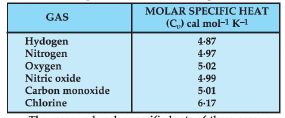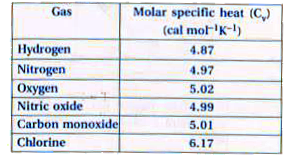Given below are observations on molar specific heats at room temperature of some common gases The measured molar specific heats of these gases are markedly different from those for monatomic gases. Typically, molar specific heat of a monatomic gas is 2.92calmolK. Explain this difference. What can you infer from the somewhat larger (than the rest) value for chlorine ?
 Solution in Punjabi
Solution in Punjabi
Step by step video & image solution for Given below are observations on molar specific heats at room temperature of some common gases The measured molar specific heats of these gases are markedly different from those for monatomic gases. Typically, molar specific heat of a monatomic gas is 2.92 cal/mol K. Explain this difference. What can you infer from the somewhat larger (than the rest) value for chlorine ? by Physics experts to help you in doubts & scoring excellent marks in Class 11 exams.
Updated on:21/07/2023Topper's Solved these Questions
Similar Questions
Answer the following :- You can shield a charge from electrical forces by putting it inside a hollow conductor. Can you shield a body from the gravitational influence of nearby matter by putting it inside a hollow sphere or by some other means ?
View SolutionExplain the term viscosity.
View SolutionThe molar specific heat capacity of all monatomic gases is the same. Is this ture of false ? (Assumed ideal nature.)
View SolutionGiven below are observations on molar specific heats at room temperature of some common gases The measured molar specific heats of these gases are markedly different from those for monatomic gases. Typically, molar specific heat of a monatomic gas is 2.92 cal/mol K. Explain this difference. What can you infer from the somewhat larger (than the rest) value for chlorine ?
View Solutionकुछ सामान्य गैसों के कक्ष ताप पर मोलर विशिष्ट ऊष्मा धारिताओं के प्रेक्षण निचे दिए गए है :


इन गैसों की मापी गयी मोलर विशिष्ट ऊष्मा धारिताएँ एक परमाणुक गैसों की मोलर विशिष्ट ऊष्मा धारिताओं से सुस्पष्ट रूप से भिन्न हैं । प्रतीकात्मक रूप में किसी एक परमाणुक गैस की मोलर विशिष्ट ऊष्मा धारिता 2.92 cal/mol K होती है । इस अंतर का स्पष्टीकरण कीजिए । क्लोरीन के लिए कुछ अधिक मान (शेष की अपेक्षा ) होने से आप क्या निष्कर्ष निकालते है ?
View SolutionMolar specific heat of a monatomic gas at constant pressure is
View SolutionAt constant volume, for different diatomic gases, the molar specific heat
View SolutionMolar specific heat at constant volume Cv for a monatomic gas is
View Solutionकुछ सामान्य गैसों के कक्ष ताप पर मोलर विशिष्ट ऊष्माधारिताओं के प्रेक्षण नीचे दिए गए हैं
गैस मोलर विशिष्ट ऊष्माधारिता (Cv)(cal mol−1K−1)
हाइड्रोजन 4.87
नाइट्रोजन 4.97
ऑक्सीजन 5.02
नाइट्रिक ऑक्साइड 4.99
कार्बन मोनोक्साइड 5.01
क्लोरीन 6.17
इन गैसों की मापी गई मोलर विशिष्ट ऊष्माधरिताएं एकपरमाणुक गैसों की मोलर विशिष्ट ऊष्माधारिताओं से सुस्पष्ट रूप से भिन्न हैं। प्रतीकात्मक रूप में किसी एकरपरमाणुक गैस की मोलर विशिष्ट ऊष्माधारिता 2.90cal/molK होती है। इस अंतर का स्पष्टीकरण कीजिए। क्लोरीन के लिए कुछ अधिक मान (शेष की अपेक्षा) होने से आप क्या निष्कर्ष निकालते हैं?
View SolutionGiven below are observations on molar specific heats at room temperature of some common gases.
GasMolar specific heat (Cv)(cal mol1K−1)Hydrogen4.87Nitrogen4.97Oxygen5.02Nitric oxide4.99Carbon monoxide5.01Chlorine6.17
The measured molar specific heats of these gases are markedly different from those for monatomic gases. Typically, molar specific heat of a monatomie gas is2.52 cal/mol K. Explain this difference. What can you infer from the somewhat larger than the rest) value for chlorine ?
View SolutionGiven below are observations on molar specific heats at room temperature of some common gases.
GasMolar specific heat (Cv)(cal mol1K−1)Hydrogen4.87Nitrogen4.97Oxygen5.02Nitric oxide4.99Carbon monoxide5.01Chlorine6.17
The measured molar specific heats of these gases are markedly different from those for monatomic gases. Typically, molar specific heat of a monatomie gas is2.52 cal/mol K. Explain this difference. What can you infer from the somewhat larger than the rest) value for chlorine ?
View SolutionGiven below are observations on molar specific heats at room temperature of some common gases.
GasMolar specific heat (Cv)(cal mol1K−1)Hydrogen4.87Nitrogen4.97Oxygen5.02Nitric oxide4.99Carbon monoxide5.01Chlorine6.17
The measured molar specific heats of these gases are markedly different from those for monatomic gases. Typically, molar specific heat of a monatomie gas is2.52 cal/mol K. Explain this difference. What can you infer from the somewhat larger than the rest) value for chlorine ?
View SolutionGiven below are observations on molar specific heats at room temperature of some common gases.
GasMolar specific heat (Cv)(cal mol1K−1)Hydrogen4.87Nitrogen4.97Oxygen5.02Nitric oxide4.99Carbon monoxide5.01Chlorine6.17
The measured molar specific heats of these gases are markedly different from those for monatomic gases. Typically, molar specific heat of a monatomie gas is2.52 cal/mol K. Explain this difference. What can you infer from the somewhat larger than the rest) value for chlorine ?
View SolutionGiven below are observations on molar specific heats at room temperature of some common gases The measured molar specific heats of these gases are markedly different from those for monatomic gases. Typically, molar specific heat of a monatomic gas is 2.92 cal/mol K. Explain this difference. What can you infer from the somewhat larger (than the rest) value for chlorine ?
View SolutionGiven below are observations on molar specific heats at room temperature of some common gases.

The measured molar specific heats of these gases are markedly different from those for monatomic gases. Typically, molar specific heat of a monatomic gas is 2.92 cal/mol K. Explain this difference. What can you infer from the somewhat larger (than the rest) value for chlorine ?
View SolutionIf the difference in the molar specific heats of a gas is equal to R what will be the difference in the molar specific heats if there are n moles?
View Solution
